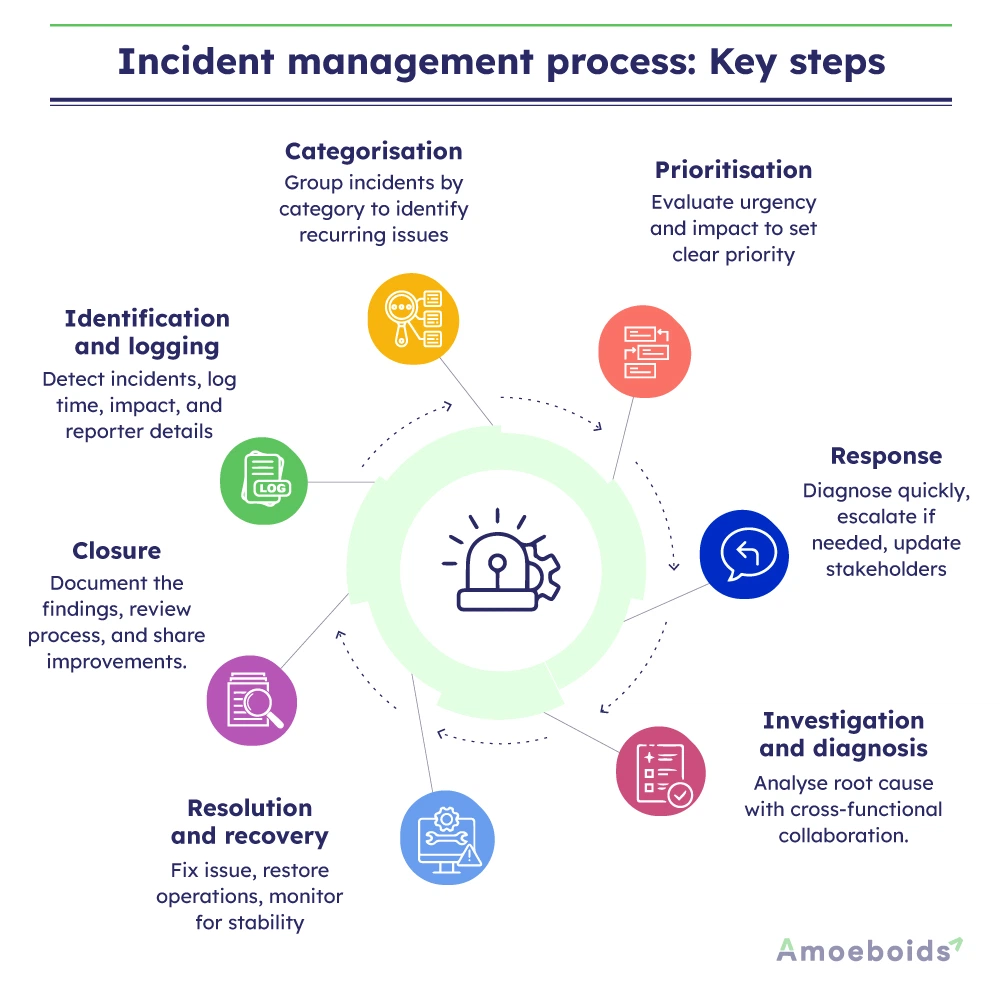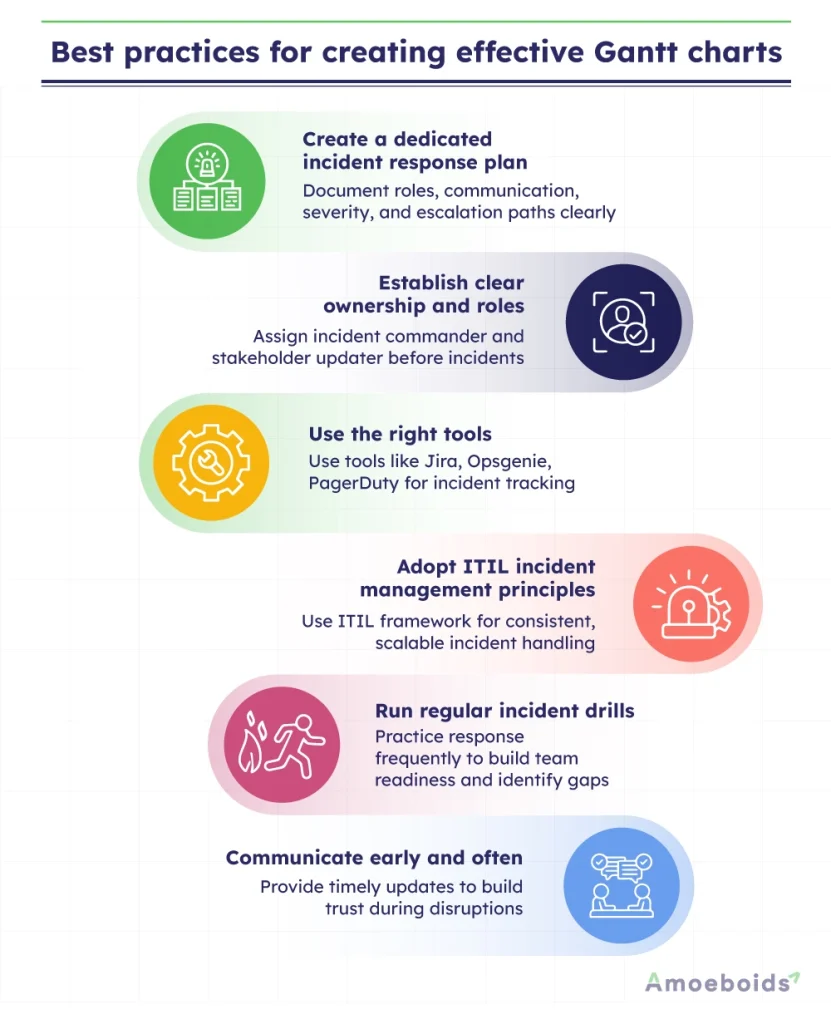Has your development team ever experienced a major system outage in the middle of a critical sprint? Operations grind to a halt; customers cannot access services; support lines are inundated with complaints. The team tries to identify and resolve the issue, but the lack of a predefined incident management plan leads to confusion and delays.
This situation is more common than many realize. According to a study by Splunk and Quocirca, the average organization experiences five critical IT incidents each month. Each incident costs the IT department around $36,326, with an additional $105,302 in downstream business impact.
The repercussions of inadequate incident management extend beyond financial losses. They can erode customer trust and damage the organization’s reputation.
In this article, we will explore the essential components of an effective incident management plan. By following a structured, step-by-step approach, you can equip your team with the tools and knowledge necessary to handle incidents efficiently, minimize downtime, and maintain customer satisfaction.
What is incident management?
Incident management is the structured process organizations use to detect, respond to, and resolve unplanned disruptions or service interruptions.
These disruptions—whether minor bugs or major system outages—can affect the availability, performance, or security of services critical to business operations.
The ultimate goal is to restore normal service operations as quickly as possible while minimizing the impact on users and the business.
In Agile and DevOps environments, where development cycles move fast and customer expectations are high, an efficient incident management process is essential. It ensures that teams understand their responsibilities, communicate effectively, and follow clearly defined recovery steps.
While tools and automation play a significant role, it is ultimately about preparation, coordination, and continuous improvement—values that align closely with Agile principles.
Why is incident management critical?
A single service disruption can halt operations and cost thousands in lost revenue. That’s why you should always have a solid plan.
Here are some key benefits of incident management:
- Minimizes downtime: A structured process helps teams respond faster, reducing the time critical systems stay offline.
- Protects user trust: When incidents are resolved quickly and transparently, customers feel reassured — even in moments of failure.
- Prevents escalation: Quick action prevents minor issues from snowballing into major outages or security breaches.
- Supports Agile delivery: Agile teams rely on stable environments to deliver value continuously. Without effective incident management, sprint goals can easily derail.
- Aligns with ITIL best practices: Adopting principles from ITIL incident management helps bring clarity, accountability, and repeatable processes to what can otherwise be chaotic situations.
- Improves team readiness: Defined workflows, communication channels, and roles mean everyone knows what to do when things go wrong.
The better your foundation, the quicker your recovery and the stronger your reputation.
Incident management process: Key steps
An effective incident management process is essential for swiftly addressing and resolving service disruptions. The following steps outline the core components:

1. Identification and logging
- Detects incidents through alerts, user reports, or monitoring tools.
- Log all details: time, impact, reporter, and description.
- Log incidents consistently to support ITIL-based tracking and accountability.
2. Categorization
- Group incidents into defined categories and subcategories.
- Spot recurring issues and streamline future handling.
3. Prioritization
- Assess urgency and impact to assign a priority level.
- Consider affected users, business functions, and any breached SLAs.
- Keep your process focused and consistent.
4. Response
- Begin with an initial diagnosis by front-line support.
- Escalate to specialized teams if needed.
- Maintain regular communication with stakeholders throughout.
5. Investigation and diagnosis
- Dig deeper into the root cause of the incident.
- Involve cross-functional teams if necessary for complex issues.
6. Resolution and recovery
- Apply the fix or workaround.
- Restore normal operations.
- Monitor systems to confirm stability.
7. Closure
- Document the incident thoroughly, including what was learned.
- Conduct a review with the team.
- Share findings and improve future management strategies.
By meticulously following these steps, organizations can enhance their capabilities, leading to reduced downtime, improved user satisfaction, and a more resilient operational framework.
Common challenges in incident management
Even with the best intentions, many teams stumble when it comes to consistent and effective incident management. Here are some of the most common hurdles organizations face:
- Unclear roles and responsibilities: When an incident hits, confusion about who does what can delay resolution. Without defined roles, teams may duplicate efforts and miss critical tasks altogether.
- Lack of a standardized process: A missing or inconsistent process leads to chaos. Without a clear workflow, teams may skip essential steps such as documentation, communication, or escalation.
- Ineffective communication: Silence during an incident can be just as damaging as the outage itself. Poor stakeholder communication creates uncertainty and erodes user trust.
- Skipping post-incident reviews: Teams often rush back to regular work without analyzing what went wrong. Without a review, the same issue is likely to resurface.
- Overlooking ITIL incident management guidelines: Ignoring proven frameworks like ITIL incident management can result in fragmented responses and missed improvement opportunities.
Recognizing these challenges is the first step toward fixing them. Once you’re aware of the gaps, you can build a more resilient, responsive approach to handling incidents.
Best practices for effective incident management
Building a plan is one thing — executing it well under pressure is another. Here are a few best practices for incident management that high-performing Agile and IT teams recommend strongly:

1. Create a dedicated incident response plan
Don’t rely on ad hoc reactions. Build a documented plan that defines roles, communication protocols, severity levels, and escalation paths.
2. Establish clear ownership and roles
Assign responsibilities before incidents happen. Who is the incident commander? Who updates stakeholders? Clear roles reduce chaos.
3. Use the right tools
Use tools like Jira Service Management, Opsgenie, or PagerDuty to log, track, and prioritize incidents. While Opsgenie handles alerting and on-call coordination, tailored solutions strengthen incident communication and transparency. For example, Automated Release Notes & Reports help generate and share detailed post-incident updates with internal teams or customers. Integrated platforms help unify your incident management workflow, making it easier for teams to stay aligned during high-pressure situations.
4. Adopt ITIL incident management principles
Incorporate structured frameworks like ITIL incident management to bring consistency, especially in large or distributed teams.
5. Run regular incident drills
Just like fire drills, practicing incident response helps the team build muscle memory and find gaps before a real crisis hits.
6. Communicate early and often
Keep internal teams and users informed. Silence causes confusion, and clear updates build trust even during disruptions.
7. Always conduct Post-Incident Reviews (PIRs)
Once resolved, analyze what went wrong, what worked, and how the process can be improved. This step fuels continuous improvement and stronger future responses.
You can build a high-trust team by applying these best practices.
Building confidence with a strong incident management plan
You can’t avoid every incident, but you can control how your team responds to one.
Having a clear, well-practised incident management approach means fewer surprises and stronger team confidence.
Start by reviewing your current practices. Where do handoffs get messy? Are stakeholders being kept in the loop? Are post-incident learnings being captured and shared? Each small improvement leads to a more mature and effective process.
And the right tools make a difference. Report automation tools can help bridge the communication gap that often follows an incident. These tools can automatically generates consistent, real-time updates for both internal teams and external stakeholders, cutting down manual effort and keeping everyone informed. Customizable templates in such tools make post-incident reporting faster, more accurate, and easier to manage under pressure.
With thoughtful planning and the right practices, your team can shift from reactive to prepared when the next incident arises.
FAQs
How does incident management differ from problem management?
It focuses on restoring service quickly, while problem management aims to identify and eliminate root causes to prevent future incidents.
What are the key steps in an incident management process?
Identification, categorization, prioritization, response, investigation, resolution, and closure, with clear roles and documentation throughout are the key steps of an incident management process.
How can organizations automate their incident management workflows?
By integrating tools like Jira Service Management, Opsgenie, or custom automations to handle alerts, escalations, and communications.
What are the most common challenges in incident response?
Unclear roles, poor communication, lack of standardized processes, and skipping post-incident reviews are the most frequent pitfalls.



